Lure fishing for pike
Pike fishing laws and permissions depend on where you are going fishing. There is a link to the national bylaws here. Some clubs also have their own requests, such as the use of landing nets and mats and barbless hooks.
Fishmag is reader-supported and earns commissions from affiliate sales, such as from amazon.
Pike fishing season
The UK government does not have a set pike fishing season. However, dedicated lure anglers often target them between October and March. This gives the fish time to spawn in spring. In summer it is best for the fish if you fish in reservoirs or deep water because pike struggle to recover from being caught when the water temperature is high, as oxygen levels are low. For instance, canal fishing for pike in summer in a city is not ideal for catch and release pike fishing.
In the Spring, pike are often in the shallows. They are trying to refeed after winter. The water has high oxygen content because it’s still cold. Shallow diving plugs and surface lures can be effective for searching out the shallows.
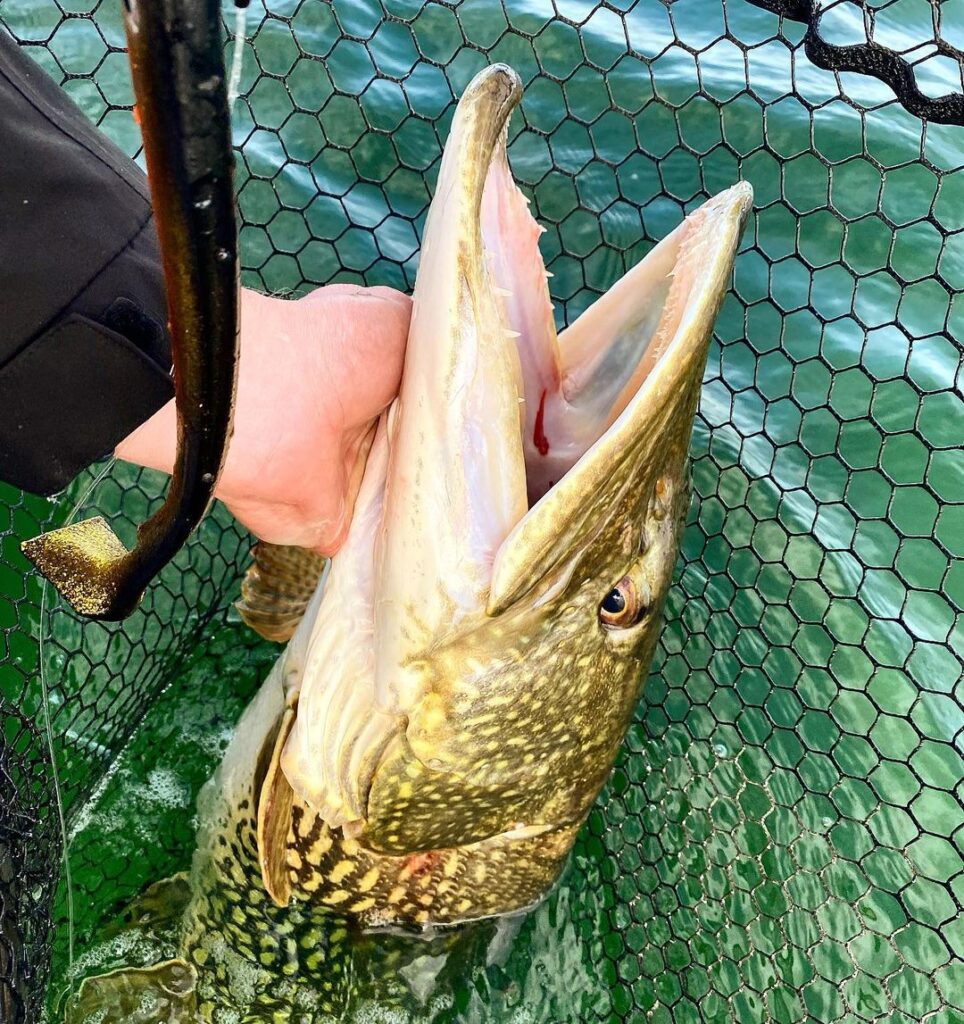
Summer pike fishing
Higher water temperatures mean that pike move further out into deeper sections of water. Pike in canals and shallower water systems are likely to be struggling if it’s a hot summer, so it’s better to target the ones in larger bodies of water with deeper, cooler areas. Much like sea bass, pike are more eager to hit surface lures in summer than in winter.
Pike fishing in Autumn
As the water cools into Autumn, the pike are at their fattest. They have huge amounts of energy to hit fast lures, and it’s worth searching out the whole water rather than focusing more around deeper water as you might in summer or shallower water as you might in spring.
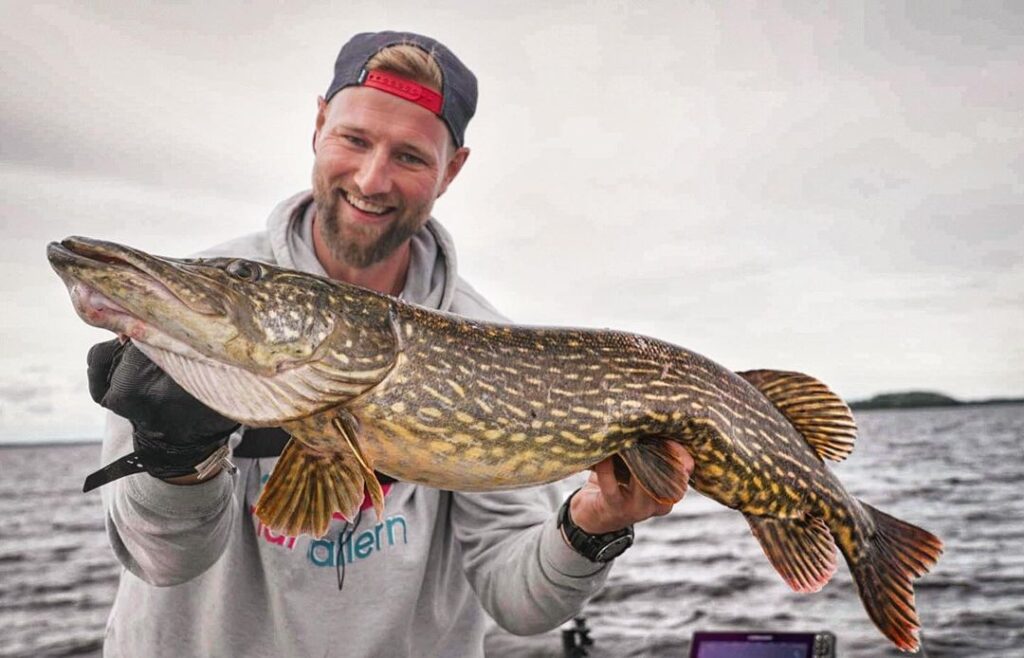
Winter pike fishing
In the winter, the metabolism of the pike has slowed down, and they are not as eager to chase fast moving lures. Instead, lures that imitate the already dead or dying are effective. Namely, lures fished OTD (on the drop) and slowly bounced near the bottom. In Winter, water clarity can be excellent because of lower algae levels. This means lure presentation is more important. It’s also true that heavy rain can ruin water quality in winter. Many will then reach for noisy and more colourful lures for the pike.
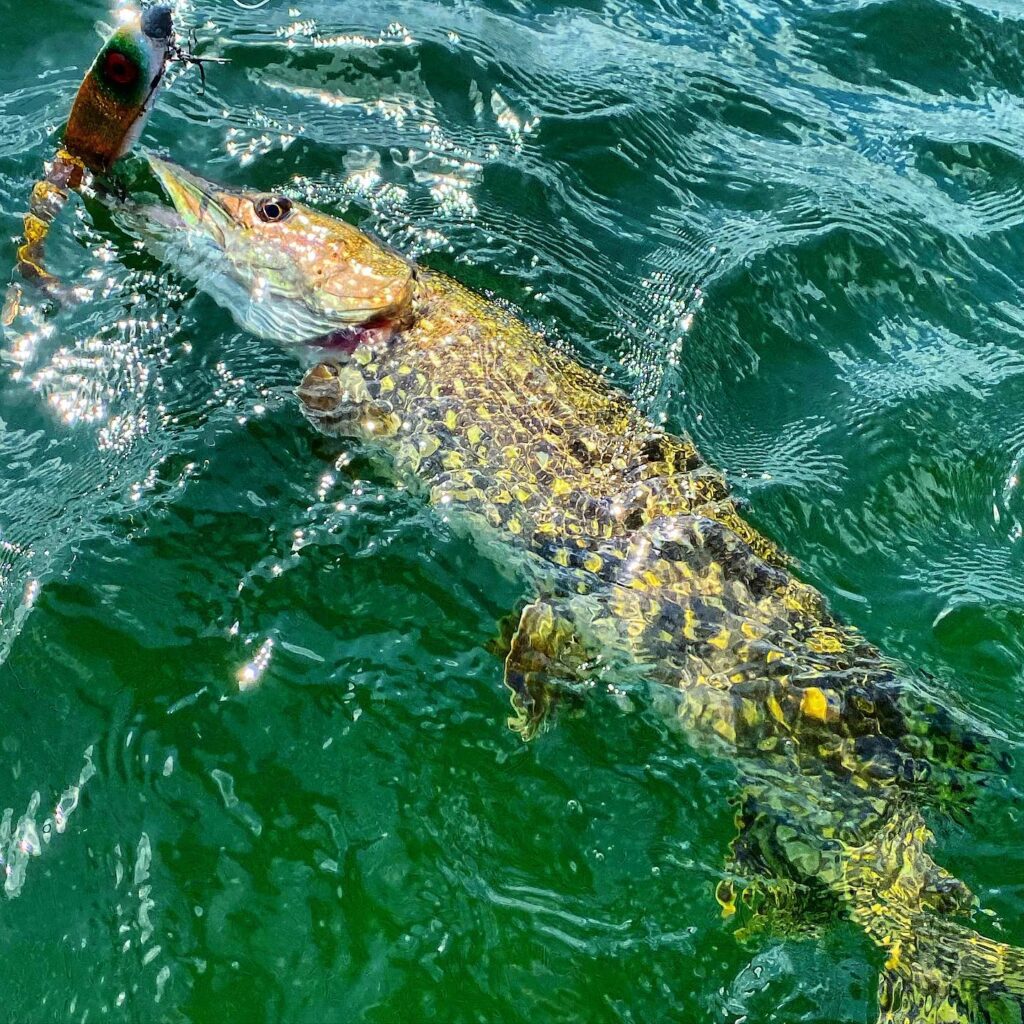
Pike fishing setup
For specific lure fishing set up recommendations, read this guide.
Best pike fishing rods
Most pike fishing with lures in the UK is done with spinning rods that cast up to a maximum of 40-60g. You can see the rods casting weight written on the underside of the rod near the reel seat. The rods for pike fishing from boats can be as short as 6ft, while in large reservoirs a longer rod up to 10ft can be useful. Much like saltwater lure fishing for bass, an 8ft rod is hugely versatile. In fact, you could use the same setup for pike we recommend for bass fishing.
Best pike fishing reels
Some anglers will choose to use a bait finesse system. This is a popular method for freshwater bass fishing in the US. Essentially, you use what looks like a small multiplier on a rod especially designed to be used with a baitcasting reel. These are prone to tangles but do have some advantages when fishing in heavy cover, as it’s possible to bounce lures across the surface and cast under low-hanging trees into tight spots you can’t otherwise reach. Certainly not an approach for beginners.
Best reels for pike fishing
The reels used for pike fishing are much the same as spinning reels used for targeting other species on lures, such as zander, perch and sea bass. A size 3000 to 4500 is best. If your rod is under 8.5ft, a 3000 is likely the best size for you. If your rod is between 8.5-10ft, a 4500 is likely the best size. Reels smaller than this – 1000/2000 size – are used by some, but are better suited for perch fishing. They won’t spool 20lb braid as well as a larger reel and won’t be much help when trying to stop a monster pike.
Reel sizes vary a lot by manufacturer, as do the weights of reels. Generally, if you buy a modern lure fishing rod, it will pair well with a lighter reel. If you use more of a traditional rod (e.g. if it was under £50 or is over 10 years old) then you’ll want a heavier reel or to lean towards a larger size.
We have a full guide to the best spinning reels.
What’s the best line for pike fishing?
A quality braided mainline gives you major advantages over fluorocarbon or monofilament. Once you’ve used braid, monofilament tends to feel very thick and restrictive when casting. A low quality braid can cause a lot of trouble with line fraying, snap offs, tangles and more.
When you use braid, you can cast further and have a superior connection to your lures because the line doesn’t stretch. This means you feel every bite and every bit of weed. Many pike anglers consider braid essential, particularly when you need to cast a long way in reservoirs or big lakes. It’s less essential in canals. The best braids have low PE ratios, which means they are thinner at the same strength class. This is not always ideal in very rough ground, so a mid-range braid is best for general pike fishing, such as Power Pro.
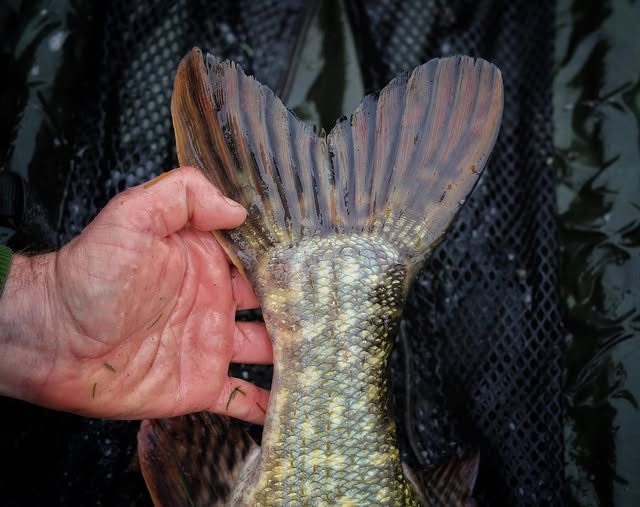
What’s the best strength line for pike fishing?
30lb braided line is the safest best when pike fishing in heavy structure where a big pike could cut you up. Most anglers would rather fish with 20-25lb for the superior casting. We recommend 25lb as a minimum if large pike are present, and recommend using a mid-range braid rather than a high end braid, because you don’t want the line to be too thin. If you fish clear-bottomed reservoirs, you may get away with higher quality or lighter lines down to 20lb.
What’s the best pike trace?
If Pike are present in a water it’s necessary to use a wire trace or else a very strong fluroucarbon trace down to your hook. The teeth on a pike easily cut through regular lines, which results in hooks being left in their mouths, most likely resulting in death for the pike.
Pike forceps & dosgorgers
Forceps are essential for pike fishing because the fish have razor sharp teeth. Without disgorgers, you will cut your hand and are likely to get hooked when removing lures from the fish’s mouth. It’s much better for the pike if they are unhooked quickly. You can remove hooks both by growing in via the mouth or underneath the gill plates.
Wire cutters
Sometimes you need to cut a wire trace because a fish is hooked awkwardly. Having a pair with you saves you and the fish time and trouble!
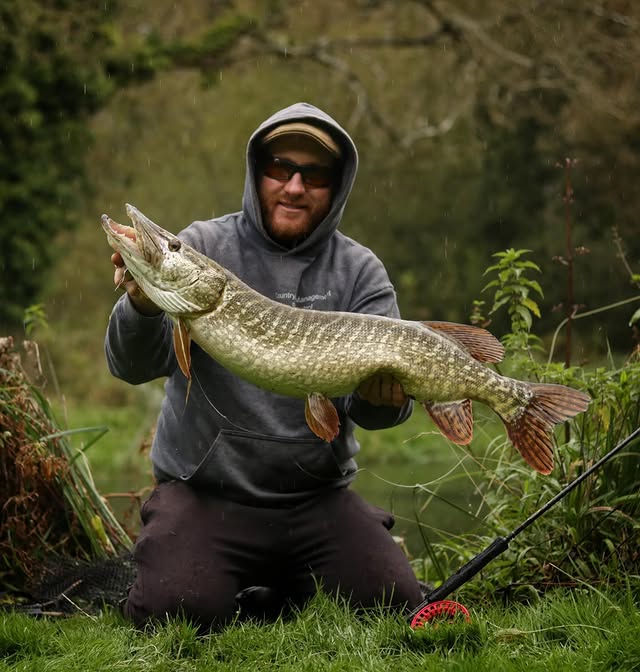
Pike landing net
Landing nets and mats are essential for pike fishing because it’s very tricky to unhook these fish while they’re still in the water, unlike some other species. If you’re fishing on a canal, you likely have no way of landing the pike at all without a net. You’ll want a net with a fairly long handle – 2m is good. Don’t buy one that’s too small or you’ll make it harder to bag that monster pike.
Landing mats
A landing mat protects the fish from the ground and protects their slime layer from being removed or the fish getting covered in dirt – not good. You need a mat about a metre long. They roll up so are easiliy portable in a backpack along with your other tackle.
Landing nets are useful for big pike especially, and not having one could you a great fish. Netes with rubber mesh prevent hooks from getting caught in the netting, which is pretty annoying. One that does the job can be viewed here.
One hack for pike fishing is to use a casting fishfinder called ‘Deeper’. It will enable you to immediately understand the underground structures and features at new (and old) venues. Some might call this cheating, but for others it’s a way of gaining much deeper insight into the marks they fish, and will of course provide a huge advantage both in avoiding tackle losses and catching pike.
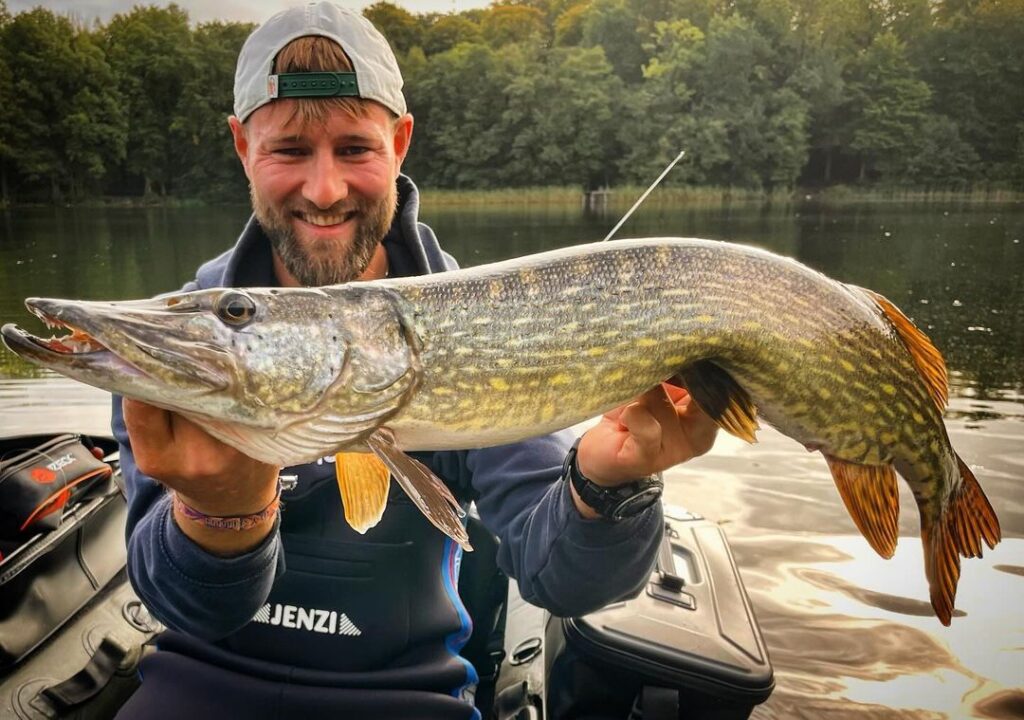
Where to catch pike
Drop offs
Like most fish, pike are fond of structure. A structure is anything that is different from open, clear-bottomed, static areas of water. For instance, the area in a lake where the water drops off into deeper water can provide pike with an ambush zone, where they can be concealed from prey until the last moment. It’s like those road signs that warn you as you drive over the arch of a steep hill that you can’t see cars coming the other way until they’re basically right on you.
With all types of structure below, try to cast around them from different angles and positions. A pike may be waiting for food and expecting it to come from a particular direction. If the pike has a slow metabolism in winter and isn’t feeding very actively, you want to make the meal you’re offering as much like Mcdonalds fast food as you can. Convenient and easy.
Lilly pad lines
One of the best areas to cast for pike is along the edges of weedy areas such as lilly pads. These provide cover for pike, attract smaller bait fish, and allow pike to conceal themselves against the green. Looking at the colour of the pike, it’s clear that this kind of cover is what they’re built for.
Like bass in saltwater – pike have routes they will follow through gulleys. Weed lines are likely to be part of these routes.
Rocks, boulders and shopping trolleys
Rough ground means more snags, but it is also heavily favoured by many insects, small bait fish, frogs and birds. Naturally the predators want to get involved.
Islands
If you’re fishing a lake with an island or an area of shallower water in the middle of a lake, these are hot spots for pike. They allow pike to ambush prey around corners without being seen, and the water temperature may be more favourable in shallow areas at certain times of year.
Shoals of fish
If you can cast onto the edges of a shoal of baitfish that’s ideal. Like other predators pike hone in on fish that appear to be separated from the shoal, so when your lure swims the wrong direction from the rest of the nearby baitfish it’s an obvious target.
Fish finders for predator fishing
Modern fish finders allow you to map out these underwater features. This intel helps you hone in on areas of structure so that more of your casts result in bites and hook ups with pike. It’s also fascinating to learn what your local waters look like beneath the murky depths.
In the fishfinder, you can place waypoints over key areas so you know which areas to target. If you fish with friends, you only need one of these between a group of you and you can map out all your marks.
Count how long it takes for your lures to reach the bottom.
Even if you don’t have a fish finder to find the best ground, you can work out the waters depth and find features with your lures. It’s good practice to figure out the depth of the water in each area of a water you’re fishing. Once you know the depth, you can modify how long you allow your lure to sink to search for pike at different depths. It’s easy to fish on set depth without realising it, and this limits your chances a lot.
Q&A
How does wind effect pike?
The wind moves little morsels of food by creating water movement. Anything on the surface will also get blown along in the same direction as the wind. While the pike may not notice this movement of insects, small baitfish like rudd do. The pike will follow these baitfish. Much like with other types of freshwater fishing, it’s usually best to follow the wind direction yourself to locate the pike.
What depth do pike feed at?
In summer fish feed throughout the whole water column, whereas in winter pike will stick closer towards the bottom.
How does cold water affect pike?
Water temperature does effect pike. In cold water, pike will move towards warmer areas. The water in cities can be warmer than that in rural locations, which may attract pike in the coldest temperatures. In summer, fish may favour cooler areas of water, because it’s better oxygenated.
The metabolism of pike increases with the water temperature. This means they have more energy to chase prey and eat more. In smaller bodied of water like canals, the water can get too warm and the oxygen levels can drop. This is especially true in more polluted rivers with high amounts of algae. The algae further strip the water of oxygen.
Rising air pressure is said by some to reduce pike catches. Falling air pressure is said to increase them. Sudden drops or raises in air temperature may make the pike fishing tougher, and the effect will be greater in smaller bodies of water. Longer periods of consistent weather could increase the chances the pike will be turned on.
Should you strike pike bites?
There are many species in the UK that it does not make sense to strike. Often striking, just increases the chances you will pull the hook away from the fish and spook it. Pike are no such fish. With hard mouths and an ability to spit hooks with ease, you need to strike. If you get a bite while pike fishing, you should strike.
If you’re struggling to catch in winter, scale down your lure size. This way you can catch perch and zander, too. You’ll still have a good chance of jack pike, and larger pike do still take smaller lures.
What time of day is best for pike fishing?
Like most fish, the best time to catch pike is around dawn and dusk when they’re feeding most actively. I don’t know why. Please get in touch if you do! Potential reasons include that pike are using the half-light to hunt more actively because they are concealed from baitfish but can still see them easily. Pike hunt happily at night, so they may be at a significant advantage in this half light. Another potential reason is that baitfish are less cautious in the half light, and the pike take advantage of this. Perhaps the baitfish are less visible to aerial predators such as birds.
